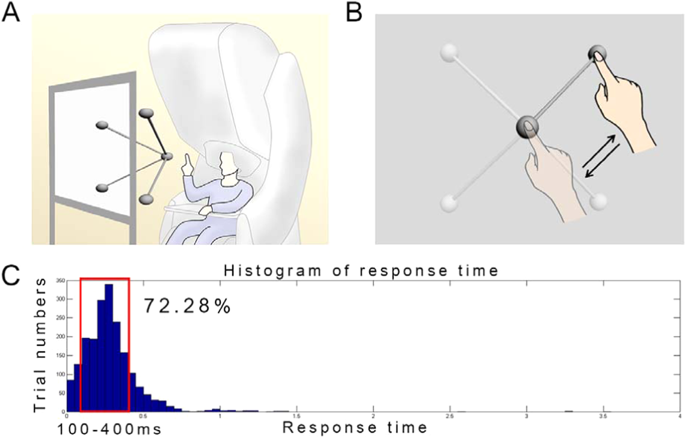Our official English website, www.x-mol.net, welcomes your
feedback! (Note: you will need to create a separate account there.)
Brain mechanisms in motor control during reaching movements: Transition of functional connectivity according to movement states.
Scientific Reports ( IF 3.8 ) Pub Date : 2020-01-17 , DOI: 10.1038/s41598-020-57489-7 Hong Gi Yeom 1 , June Sic Kim 2 , Chun Kee Chung 2, 3, 4
Scientific Reports ( IF 3.8 ) Pub Date : 2020-01-17 , DOI: 10.1038/s41598-020-57489-7 Hong Gi Yeom 1 , June Sic Kim 2 , Chun Kee Chung 2, 3, 4
Affiliation

|
Understanding how the brain controls movements is a critical issue in neuroscience. The role of brain changes rapidly according to movement states. To elucidate the motor control mechanism of brain, it is essential to investigate the changes in brain network in motor-related regions according to movement states. Therefore, the objective of this study was to investigate the brain network transitions according to movement states. We measured whole brain magnetoencephalography (MEG) signals and extracted source signals in 24 motor-related areas. Functional connectivity and centralities were calculated according to time flow. Our results showed that brain networks differed between states of motor planning and movement. Connectivities between most motor-related areas were increased in the motor-planning state. In contrast, only connectivities with cerebellum and basal ganglia were increased while those of other motor-related areas were decreased during movement. Our results indicate that most processes involved in motor control are completed before movement. Further, brain developed network related to feedback rather than motor decision during movements. Our findings also suggest that neural signals during motor planning might be more predictive than neural signals during movement. They facilitate accurate prediction of movement for brain-machine interfaces and provide insight into brain mechanisms in motor control.
中文翻译:

达到运动过程中运动控制中的脑机制:根据运动状态进行功能连接的转换。
了解大脑如何控制运动是神经科学中的关键问题。大脑的作用根据运动状态而迅速变化。为了阐明大脑的运动控制机制,必须根据运动状态研究运动相关区域的大脑网络变化。因此,本研究的目的是研究根据运动状态的大脑网络转换。我们测量了24个运动相关区域的全脑磁脑电图(MEG)信号并提取了源信号。根据时间流计算功能连接性和中心性。我们的结果表明,大脑网络在运动计划和运动状态之间存在差异。在运动计划状态下,大多数与运动有关的区域之间的连通性增加了。相反,在运动过程中,只有与小脑和基底神经节的连接增加,而与其他运动相关区域的连接减少。我们的结果表明,电机控制中涉及的大多数过程都是在运动之前完成的。此外,大脑发展的网络与运动过程中的反馈而非运动决定有关。我们的发现还表明,运动计划过程中的神经信号可能比运动过程中的神经信号更具预测性。它们有助于准确预测脑机接口的运动,并深入了解运动控制中的脑机制。大脑发育的网络与反馈有关,而不是运动过程中的运动决策。我们的发现还表明,运动计划过程中的神经信号可能比运动过程中的神经信号更具预测性。它们有助于准确预测脑机接口的运动,并深入了解运动控制中的脑机制。大脑发育的网络与反馈有关,而不是运动过程中的运动决策。我们的发现还表明,运动计划过程中的神经信号可能比运动过程中的神经信号更具预测性。它们有助于准确预测脑机接口的运动,并深入了解运动控制中的脑机制。
更新日期:2020-01-17
中文翻译:

达到运动过程中运动控制中的脑机制:根据运动状态进行功能连接的转换。
了解大脑如何控制运动是神经科学中的关键问题。大脑的作用根据运动状态而迅速变化。为了阐明大脑的运动控制机制,必须根据运动状态研究运动相关区域的大脑网络变化。因此,本研究的目的是研究根据运动状态的大脑网络转换。我们测量了24个运动相关区域的全脑磁脑电图(MEG)信号并提取了源信号。根据时间流计算功能连接性和中心性。我们的结果表明,大脑网络在运动计划和运动状态之间存在差异。在运动计划状态下,大多数与运动有关的区域之间的连通性增加了。相反,在运动过程中,只有与小脑和基底神经节的连接增加,而与其他运动相关区域的连接减少。我们的结果表明,电机控制中涉及的大多数过程都是在运动之前完成的。此外,大脑发展的网络与运动过程中的反馈而非运动决定有关。我们的发现还表明,运动计划过程中的神经信号可能比运动过程中的神经信号更具预测性。它们有助于准确预测脑机接口的运动,并深入了解运动控制中的脑机制。大脑发育的网络与反馈有关,而不是运动过程中的运动决策。我们的发现还表明,运动计划过程中的神经信号可能比运动过程中的神经信号更具预测性。它们有助于准确预测脑机接口的运动,并深入了解运动控制中的脑机制。大脑发育的网络与反馈有关,而不是运动过程中的运动决策。我们的发现还表明,运动计划过程中的神经信号可能比运动过程中的神经信号更具预测性。它们有助于准确预测脑机接口的运动,并深入了解运动控制中的脑机制。











































 京公网安备 11010802027423号
京公网安备 11010802027423号